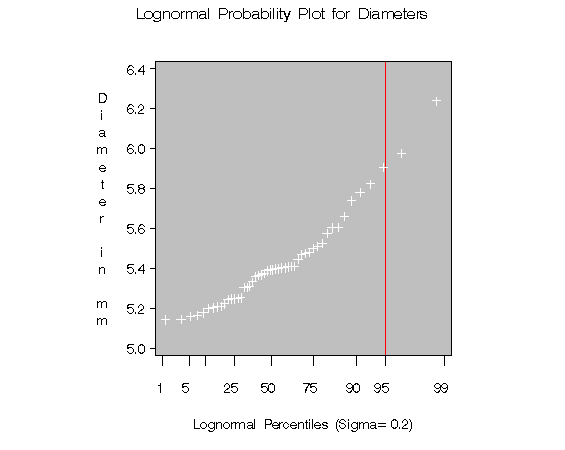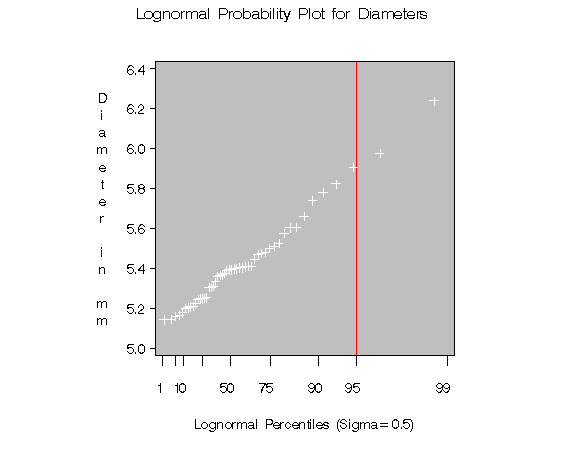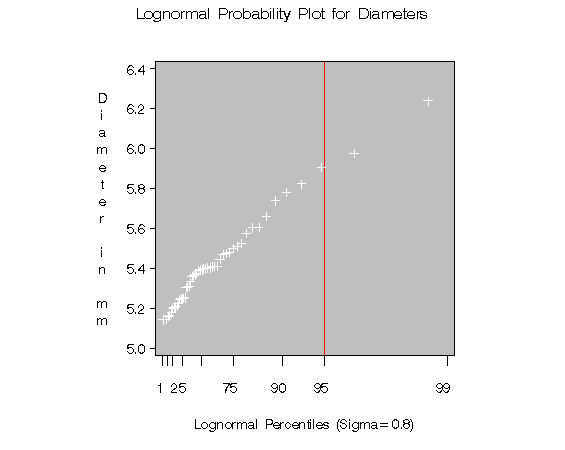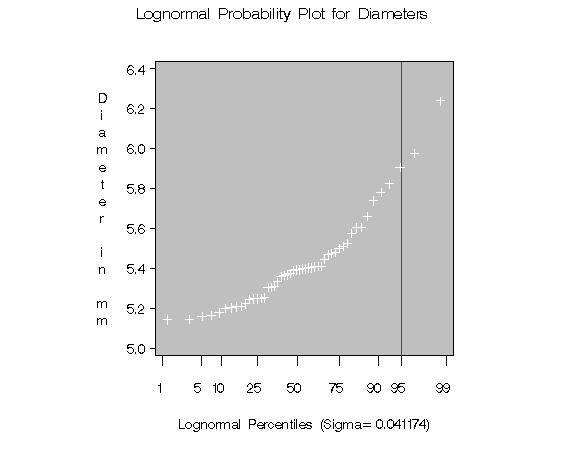Chapter Contents
Previous
Next
|
Chapter Contents |
Previous |
Next |
| PROBPLOT Statement |
| See CAPPROB3 in the SAS/QC Sample Library |
When you request a lognormal probability plot,
you must specify
the shape parameter ![]() for the lognormal distribution
(see Table 9.13 for the equation).
The value of
for the lognormal distribution
(see Table 9.13 for the equation).
The value of ![]() must be positive, and
typical values of
must be positive, and
typical values of ![]() range from 0.1 to 1.0.
Alternatively, you can specify that
range from 0.1 to 1.0.
Alternatively, you can specify that ![]() is to be
estimated from the data.
is to be
estimated from the data.
The following statements illustrate the first approach by creating a series of three lognormal probability plots for the variable DIAMETER introduced in the preceding example:
title 'Lognormal Probability Plot for Diameters';
proc capability data=measures noprint;
probplot diameter / lognormal(sigma=0.2 0.5 0.8
color=yellow)
HREF=95
lHREF=1
square
cHREF=red
cframe = ligr;
run;
The LOGNORMAL option requests plots based on the lognormal
family of distributions, and the
SIGMA= option requests plots for ![]() equal to
0.2, 0.5, and 0.8.
These plots are displayed in
Figure 9.3,
Figure 9.4,
and
Figure 9.5, respectively.
The value
equal to
0.2, 0.5, and 0.8.
These plots are displayed in
Figure 9.3,
Figure 9.4,
and
Figure 9.5, respectively.
The value ![]() in Figure 9.4
produces the most linear pattern.
in Figure 9.4
produces the most linear pattern.
The SQUARE option displays the probability plot in a square format, the HREF=option requests a reference line at the 95 th percentile, and the LHREF=option specifies the line type for the reference line.

|

|

|
Based on Figure 9.4, the 95 th percentile of the diameter distribution is approximately 5.9 mm, since this is the value corresponding to the intersection of the point pattern with the reference line.
The following statements illustrate how you can
create a lognormal probability plot for DIAMETER
using a local maximum likelihood estimate for ![]() .
.
title 'Lognormal Probability Plot for Diameters';
proc capability data=measures noprint;
probplot diameter / lognormal(sigma=est
color=yellow)
HREF=95
lHREF=1
square
cHREF=red
cframe = ligr;
run;
The plot is displayed in
Figure 9.6.
Note that the maximum likelihood estimate of ![]() (in this case 0.041)
does not necessarily produce the most linear point
pattern.
This example is continued in
Example 9.2.
(in this case 0.041)
does not necessarily produce the most linear point
pattern.
This example is continued in
Example 9.2.

|
|
Chapter Contents |
Previous |
Next |
Top |
Copyright © 1999 by SAS Institute Inc., Cary, NC, USA. All rights reserved.